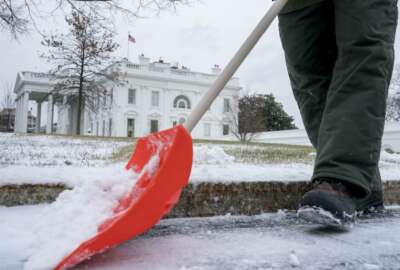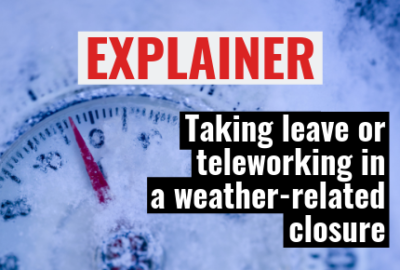
Telework or snow day? OPM offers up leave policy reminders ahead of winter weather
With winter around the corner, the Office of Personnel Management is reminding federal employees how they should respond to an operating status announcement, and...
Winter is apparently right around the corner, and the Office of Personnel Management has some timely advice for federal employees who are still adjusting to the year-old changes to leave and telework policies ahead of winter weather.
Nothing about OPM’s dismissal and closure procedures is changing this year, but a new memo from the agency serves as a reminder for federal employees as winter approaches.
OPM initially updated these procedures last November to reflect new changes under the Administrative Leave Act. Congress had instructed OPM in 2016 to create four different types of leave, including a revamped administrative leave, investigative leave, “notice leave” and “weather and safety leave.”
After nearly three years, agencies still don’t have the regulations needed to implement “administrative” or “investigative” leave as envisioned by Congress back in 2016. Those policies have been delayed, according to lawmakers, due to a challenge with the existing text of the Administrative Leave Act.
But agencies have had the regulations they need to implement “weather and safety” leave for a little more than a year.
In general, the regulations allow OPM to grant “weather and safety leave” due to an “act of God”: a terrorist attack or other emergency condition that prevents employees from safely traveling to or performing work at the office or other work site.
But teleworkers are in a different boat. If you’re eligible and equipped to telework, your agency will generally expect you to work remotely instead of taking a snow day — or what’s more accurately described as weather or safety leave.
Federal employees who aren’t eligible to telework can use weather and safety leave, per approval from their agencies.
Agencies typically grant weather and safety leave in conjunction with an operating status announcement from OPM. If, for example, OPM has announced a two-hour delayed opening, agencies could grant up to two hours of weather and safety leave for employees who can’t safely report to work at their normal time.
OPM’s dismissal and closure guidance describes a wide variety of possible scenarios for teleworkers and non-teleworkers alike during emergency or weather-related situations.
Of course, there are always exceptions and changes to the norm depending on an employee’s home and child care situation and the circumstances of the weather event. Federal News Network has mapped out a few potential scenarios, and how you should respond to them according to OPM guidance, below.
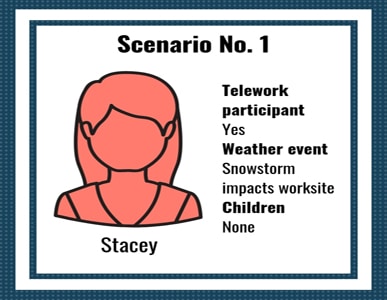
Stacey’s agency announces that the agency is open with the option for “unscheduled telework or unscheduled leave." Stacey notifies her supervisor that she intends to perform unscheduled telework and starts to work at her normal start time.
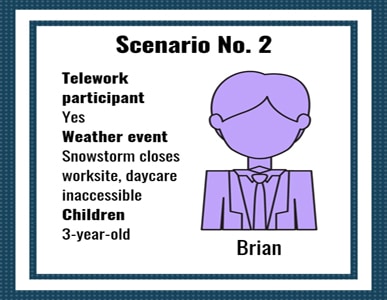
Brian’s agency bars employees from performing telework when children are in the home without supervision by another adult. Since Brian cannot safely travel to the worksite and he cannot perform telework due to his agency’s policy, Brian’s agency may grant him weather and safety leave for the entire workday.
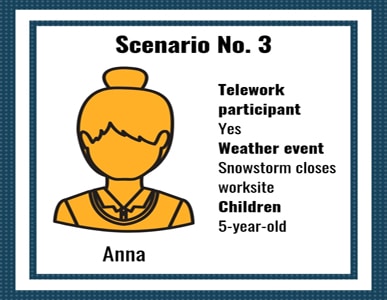
Anna’s agency permits employees under limited circumstances to telework when children are in the home without supervision by another adult only when a closure is announced. However, employees may only count those hours during which agency work is done. Time Anna spends providing care to her son may not be counted. Anna can telework in the morning for five hours but must take paid or unpaid leave or other time off to care for her son.
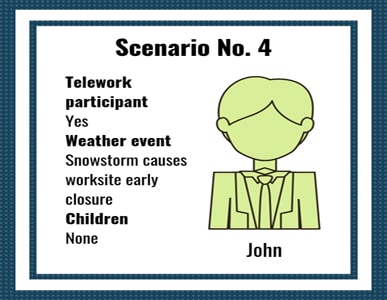
Jon leaves three hours early at 1:30 p.m. and gets home at 2:30 p.m. He completes his workday via telework and receives weather and safety leave for the time to commute home. If Jon chooses not to complete the workday once he gets home, he must request unscheduled leave or other paid time off for the remainder of the day (2:30-4:30 p.m.) or a combination of both leave and other paid time off and telework.
See a full roundup of potential scenarios here.
OPM’s most recent memo clarifies even more exceptions.
Agencies may grant weather and safety leave to employees who, for example, have flooding at their homes, especially if their approved telework site is considered unsafe, OPM said.
In addition, agencies may also grant weather and safety leave to employees who are eligible to telework but, for example, couldn’t anticipate the severe weather and didn’t bring home the equipment needed to work remotely.
And because each agency has its own telework policy, each organization may make its own determination on whether employees can work remotely while caring for children at home, OPM said.
As always, federal employees in the Washington, D.C., area should look for an operating status announcement from OPM. These announcements apply to all employees working at agencies inside the Washington Capital beltway.
OPM this year urged agencies to help familiarize employees with these operating status announcements.
“Each agency should have in place specific procedures that are applied in conjunction with the various operating status announcements,” OPM’s reminder reads. “These agency procedures will allow employees to know what is expected of them when operating status announcements are issued.”
Employees working at agencies outside the Washington-area beltway should look for announcements from their own agencies. Federal Executive Boards (FEBs), which are located in 28 metropolitan areas across the United States, usually recommend how agencies in the region should respond to a weather event.
The FEBs issue recommendations after consulting with the General Services Administration, Federal Protective Service, National Weather Service and local public safety officers; it’s ultimately up to each agency to make their own weather calls.
Graphics by Amelia Brust
Copyright © 2025 Federal News Network. All rights reserved. This website is not intended for users located within the European Economic Area.
Nicole Ogrysko is a reporter for Federal News Network focusing on the federal workforce and federal pay and benefits.
Follow @nogryskoWFED




